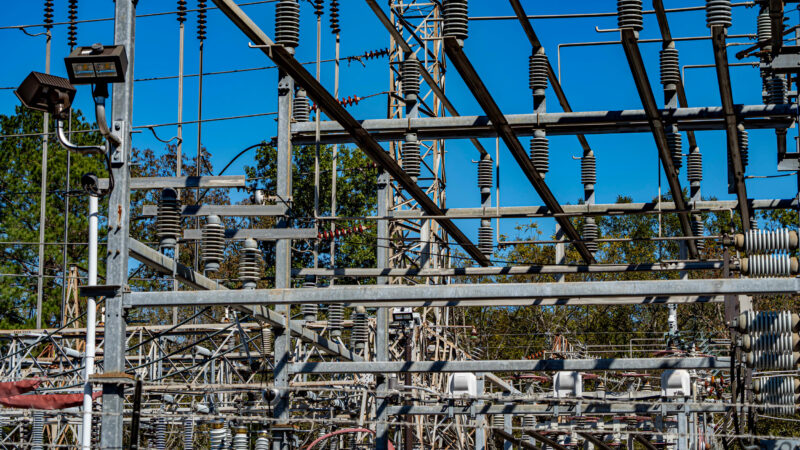How Historic Food Stamps Boost Will Bring Relief To Southern Families: ‘This Is A Really Big Deal’
In this file photo, a group of people shop in the produce section of a Trader Joe’s grocery store in Metairie, Louisiana.
Millions of Americans receiving assistance with food and groceries will see an increase in their benefits this fall thanks to new legislation approved by the Biden Administration on Monday.
Benefits from the Supplemental Nutrition Assistance Program (SNAP), often referred to as food stamps, will go up about 25% starting October 1. The change will equal to an increase of a little more than $36 for the average person on SNAP— the largest single increase the program has seen to date.
Advocates and experts hail the move as a big win in the United States’ battle against hunger and poverty for the 38 million Americans who receive SNAP benefits each month to help cover food bills, especially in Southern states that more heavily rely on the program due to higher rates of poverty. In the Gulf South, about one out of every six people received benefits across Alabama, Louisiana and Mississippi in 2019.
The increase also bolsters the social safety net at a time when families face financial burdens as coronavirus pandemic relief programs expire.
“This is a really big deal,” said Wafa Orman, associate professor of economics at The University of Alabama in Huntsville. “A lot of people’s budgets were being pinched very badly and this will come as a huge relief.”
The program’s update is due in part to keep up with inflation, which drove up food prices over the last year during the pandemic. SNAP benefits were temporarily increased by 15% in March through the end of September, though families and advocates worried what would happen when that additional increase ended. The new boost is not only higher in amount but also permanent, relieving some of those concerns — going into effect right as the temporary increase ends.
“It was just like a weight lifted,” said Myiesha Burroughs, a mom caring for five kids in Bessemer, Alabama. “It was just like finally somebody that understands it.”
The extra money is also meant to allow families to have a healthier, more modern diet. The United States Department of Agriculture based the old Thrifty Food Plan, which they use to calculate SNAP benefits, on a typical American diet in 1975.
“The Thrifty Food Plan did things like assume that people were eating pounds and pounds of dried beans,” said Carol Gundlach, a policy analyst with Alabama Arise. “That would be dinner. Well, we know nobody eats like that anymore.”
The changes are meant to reflect “notable shifts in the food marketplace and consumers’ circumstances over the past 45 years,” according to the USDA’s press release. The updated diet places a larger emphasis on fish, as well as red and orange vegetables, like sweet potatoes and carrots.
The increase will also be a big economic boost for Southern states. Mississippi, Alabama and Louisiana will get an additional $950 million from SNAP estimated for this next fiscal year. According to the Centers On Budget And Policy Priorities, SNAP is one of the fastest ways of injecting dollars into a state’s economy.
“For all of us who go to the grocery store, we need the SNAP program,” Gundlach said. “[It] helps keep our grocery stores open. It helps keep our neighbors employed.”
The update, however, is not a cure-all for solving hunger in the country. It can be difficult navigating the welfare bureaucracy to access SNAP, and for many families, the increase will still fail to cover their monthly grocery bills.
Experts also say SNAP recipients should be provided more education on how to shop, both for healthy eating and for stretching those benefits out further.
“Some people just go into the grocery store and just pick up, pick up, pick up instead of planning,” said Laurie Smith Lawson, chair of the Department of Sociology and Social Work at Mississippi College. “Education and training is also important along with the benefits.”
Will Walker’s SNAP benefits currently last about halfway through the month. He is diabetic, so he tries to stick with fruits and meats when shopping, despite the higher costs that often come with a healthier diet.
Walker, who also volunteers with the Louisiana advocacy organization Step Up Louisiana, said he is happy about the increase in benefits but still expects to rely on food banks when SNAP benefits fail to cover a full month’s groceries.
“I was like ‘wow, thank God that somebody is thinking about us,’” Walker said. “It’s not much, but it’s something.”
This story was produced by the Gulf States Newsroom, a collaboration between Mississippi Public Broadcasting, WBHM in Birmingham, Alabama, WWNO in New Orleans and NPR.
Alabama regulators approve two-year electric rate freeze and two solar projects for a Meta data center
Critics say the rate freeze will only delay financial burdens on Alabama Power customers while preserving a high profit rate for the utility.
Auburn tabs USF’s Alex Golesh as its next coach, replacing Hugh Freeze on the Plains
The 41-year-old Golesh, who was born in Russia and moved to the United State at age 7, is signing a six-year contract that averages more than $7 million annually to replace Hugh Freeze. Freeze was fired in early November after failing to fix Auburn’s offensive issues in three seasons on the Plains.
Alabama Power seeks to delay rate hike for new gas plant amid outcry
The state’s largest utility has proposed delaying the rate increase from its purchase of a $622 million natural gas plant until 2028.
Former U.S. Sen. Doug Jones announces run for Alabama governor
Jones announced his campaign Monday afternoon, hours after filing campaign paperwork with the Secretary of State's Office. His gubernatorial bid could set up a rematch with U.S. Sen. Tommy Tuberville, the Republican who defeated Jones in 2020 and is now running for governor.
Scorching Saturdays: The rising heat threat inside football stadiums
Excessive heat and more frequent medical incidents in Southern college football stadiums could be a warning sign for universities across the country.
The Gulf States Newsroom is hiring an Audio Editor
The Gulf States Newsroom is hiring an Audio Editor to join our award-winning team covering important regional stories across Mississippi, Alabama and Louisiana.









